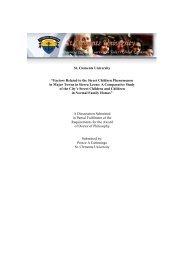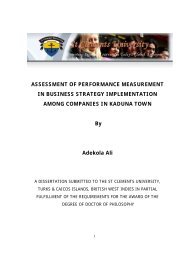The role of informal microfinance institutions in saving
The role of informal microfinance institutions in saving
The role of informal microfinance institutions in saving
Create successful ePaper yourself
Turn your PDF publications into a flip-book with our unique Google optimized e-Paper software.
loans to their respective members <strong>in</strong> both rural and urban areas. Also <strong>in</strong> rural areas, SACCOs<br />
will be regarded as important organs <strong>in</strong> the development <strong>of</strong> agriculture through provision <strong>of</strong><br />
credits to farmers for the purchase agriculture <strong>in</strong>puts, which will supplement the activities <strong>of</strong><br />
formal farmers’ cooperative unions. <strong>The</strong> challenge that still face these <strong><strong>in</strong>stitutions</strong> engag<strong>in</strong>g <strong>in</strong><br />
micro-f<strong>in</strong>ance as one means <strong>of</strong> reduc<strong>in</strong>g poverty <strong>in</strong> both rural and urban areas <strong>in</strong> Tanzania,<br />
stood out from past experience, f<strong>in</strong>ancial services should be delivery to low <strong>in</strong>come<br />
communities on a large scale, by allow<strong>in</strong>g an <strong>in</strong>stitution be susta<strong>in</strong>able by follow<strong>in</strong>g the rule <strong>of</strong><br />
the market. This means that fees and <strong>in</strong>terest rates will cover the cost <strong>of</strong> operations <strong>in</strong>clud<strong>in</strong>g<br />
some loan loss reserves, cost <strong>of</strong> funds and <strong>in</strong>flation charges, which will be usually to be above<br />
that market rates.<br />
Poor <strong>in</strong>frastructure that rema<strong>in</strong>s among the major problems for a long time that prevents<br />
f<strong>in</strong>ancial NGOs and formal banks to extend their micro-f<strong>in</strong>ance services to more rural areas.<br />
<strong>The</strong> current move by the government to improve rural <strong>in</strong>frastructure as part <strong>of</strong> its poverty<br />
reduction strategy will therefore facilitate better and fast delivery <strong>of</strong> micro-f<strong>in</strong>ance services <strong>in</strong><br />
rural areas; thereby facilitat<strong>in</strong>g poverty reduction <strong>in</strong> the country.<br />
Other limit<strong>in</strong>g factors to the success <strong>of</strong> MFIs could be ascerta<strong>in</strong>ed <strong>in</strong> terms <strong>of</strong> NGOs and banks<br />
engag<strong>in</strong>g <strong>in</strong> micro-f<strong>in</strong>ance activities. As MFIs adjust to the reality <strong>of</strong> high cost, low marg<strong>in</strong><br />
bus<strong>in</strong>ess, by apply<strong>in</strong>g realistic <strong>in</strong>terest rates to cover their costs, they will also adjust their staff,<br />
structure and procedures <strong>in</strong> order to m<strong>in</strong>imize the risks <strong>of</strong> default payment and costs. In this<br />
respect, commercial banks must design procedures to deal with small and illiterate borrowers if<br />
they are to engage <strong>in</strong> micro-f<strong>in</strong>ance activities.<br />
Many people <strong>in</strong> both urban and rural areas are not aware <strong>of</strong> what type <strong>of</strong> project(s) is viable<br />
and pr<strong>of</strong>itable. This implies that households seek<strong>in</strong>g micro-loans should seek tra<strong>in</strong><strong>in</strong>g and other<br />
important <strong>in</strong>formation to know which project(s) will be pr<strong>of</strong>itable and susta<strong>in</strong>able before<br />
consider<strong>in</strong>g tak<strong>in</strong>g loans. This will reduce the chances <strong>of</strong> operat<strong>in</strong>g at a loss. This implies that<br />
bus<strong>in</strong>ess service development will be very important. Hence creditors should help micro-<br />
borrowers by tra<strong>in</strong><strong>in</strong>g them on how to run bus<strong>in</strong>ess pr<strong>of</strong>itability.<br />
1.1.22: LIMITATIONS AND SCOPE OF THE STUDY:<br />
91
















